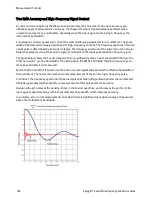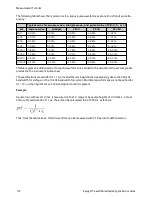
True RMS AC Measurements
True rms responding multimeters, like the Keysight True
volt
Series, measure the "heating" potential of an
applied voltage. Power dissipated in a resistor is proportional to the square of an applied voltage, inde-
pendent of the waveshape of the signal. This multimeter accurately measures true rms voltage or current,
as long as the wave shape contains negligible energy above the meter’s effective bandwidth.
The Keysight True
volt
Series uses the same techniques to measure true rms voltage and true rms current.
The effective AC voltage bandwidth is 300 kHz, while the effective AC current bandwidth is 10 kHz.
The DMM's AC voltage and AC current functions measure the AC-coupled true rms value. In this DMM,
the "heating value" of only the AC components of the input waveform are measured (dc is rejected). As
seen in the figure above; for sine waves, triangle waves, and square waves, the AC–coupled and AC+DC val-
ues are equal, because these waveforms do not contain a DC offset. However, for non–symmetrical wave-
forms (such as pulse trains) there is a DC voltage content, which is rejected by Keysight’s AC–coupled true
rms measurements. This can provide a significant benefit.
An AC–coupled true rms measurement is desirable when you are measuring small AC signals in the pres-
ence of large DC offsets. For example, this situation is common when measuring AC ripple present on DC
power supplies. There are situations, however, where you might want to know the AC+DC true rms value.
You can determine this value by combining results from DC and AC measurements, as shown below:
For the best AC noise rejection, you should perform the DC measurement using an integration time of at
least 10 power–line cycles (PLCs).
Keysight True
volt
Series Operating and Service Guide
167
Measurement Tutorial
















































